前言:很多面试题都很抽象,不是很容易找到解决的办法。画图可以帮助自己去分析、推理面试题。下面用几个例题进行举例。
面试题19:
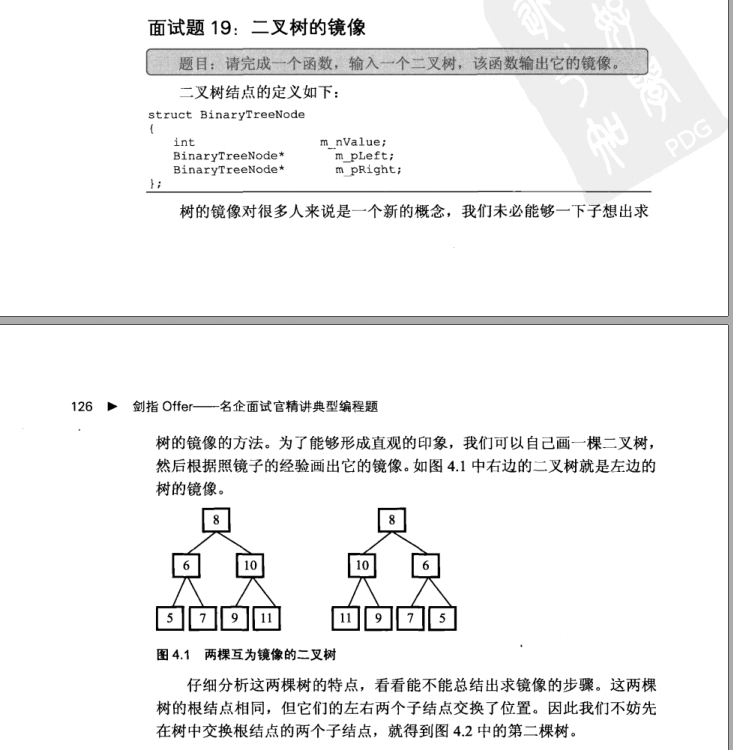
镜像对于很多人来说是一个新的概念,未必一下子能想出来树的镜像;于是可以自己画一下,代码如下:
#include<iostream> #include<cstdlib> using namespace std; struct BinaryTreeNode { int data; //节点数据 BinaryTreeNode *lchild,*rchild; //左孩子、右孩子 }; typedef struct BinaryTreeNode tree_t; /****** 构造一个二叉树 递归实现 参数:形参1:开始值,形参2:结束值 ******/ tree_t *CreateTree(int i, int max) { //递归结束条件 if(i > max) { return NULL; // == return 0; } tree_t *T; T = (tree_t *)malloc(sizeof(tree_t)); T->data = i; T->lchild = CreateTree(2*i, max); T->rchild = CreateTree(2*i+1, max); return T; } //先序遍历输出二叉树 void FirstRoot_DLR(tree_t *p) { if(p == NULL) return ; cout << " " << p->data; FirstRoot_DLR(p->lchild); FirstRoot_DLR(p->rchild); } //中序遍历输出二叉树 程序中未使用 void MiddleRoot_DLR(tree_t *p) { if(p == NULL) return; MiddleRoot_DLR(p->lchild); cout << " " << p->data; MiddleRoot_DLR(p->rchild); } //后序遍历输出二叉树 程序中未使用 void LastRoot_DLR(tree_t *p) { if(p == NULL) return; LastRoot_DLR(p->lchild); LastRoot_DLR(p->rchild); cout << " " << p->data; } void MirrorRecursively(tree_t *pNode) { if((pNode==NULL) || (pNode->lchild==NULL&&pNode->rchild==NULL)) return; tree_t *pTemp = pNode->lchild; pNode->lchild = pNode->rchild; pNode->rchild = pTemp; if(pNode->lchild) MirrorRecursively(pNode->lchild); if(pNode->rchild) MirrorRecursively(pNode->rchild); } int main() { tree_t *T1 = CreateTree(1,3); FirstRoot_DLR(T1); cout << endl; MirrorRecursively(T1); FirstRoot_DLR(T1); cout << endl; return 0; }
面试题20:
题目如下:
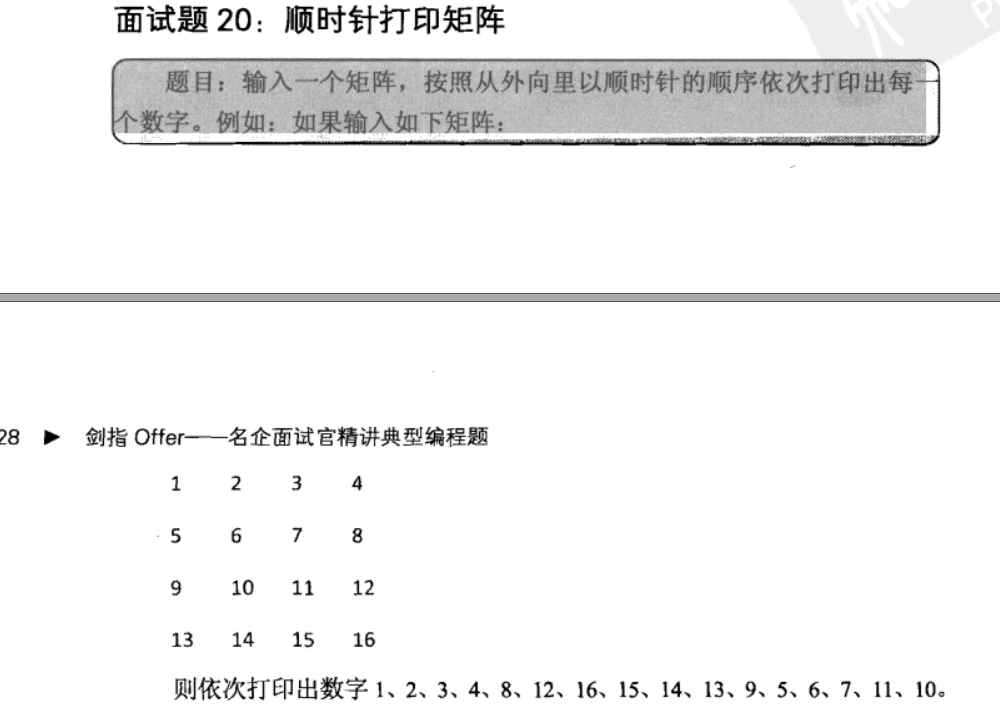
代码如下:
#include<iostream> using namespace std; void printNum(int num) { cout << " " << num; } void PrintMatrixInCircle(int (*numbers)[4],int col,int row,int start) { int endX = col-1-start; int endY = row-1-start; //从左到右打印一行 for(int i=start;i<endX;++i) { int num = numbers[start][i]; printNum(num); } //从上到下打印一行 if(start < endY) { for(int i=start+1;i<=endY;++i) { int num = numbers[i][endX]; printNum(num); } } //从右到左打印一行 if(start<endX && start<endY) { for(int i=endX-1;i>=start;--i) { int num = numbers[endY][i]; printNum(num); } } //从下到上打印一行 if(start<endX && start<endY-1) { for(int i=endY-1;i>=start+1;--i) { int num = numbers[i][start]; printNum(num); } } } void PrintMatrixClockwisely(int (*numbers)[4],int col,int row) { if(numbers==NULL || col<=0 || row<=0) return; int start = 0; while(col>start*2 && row>start*2) { PrintMatrixInCircle(numbers,col,row,start); ++start; } } int main() { int num[4][4]={{1,2,3,4},{5,6,7,8},{9,10,11,12},{13,14,15,16}}; PrintMatrixClockwisely(num,4,4); cout << endl; return 0; }
面试题21:
面试题如下:
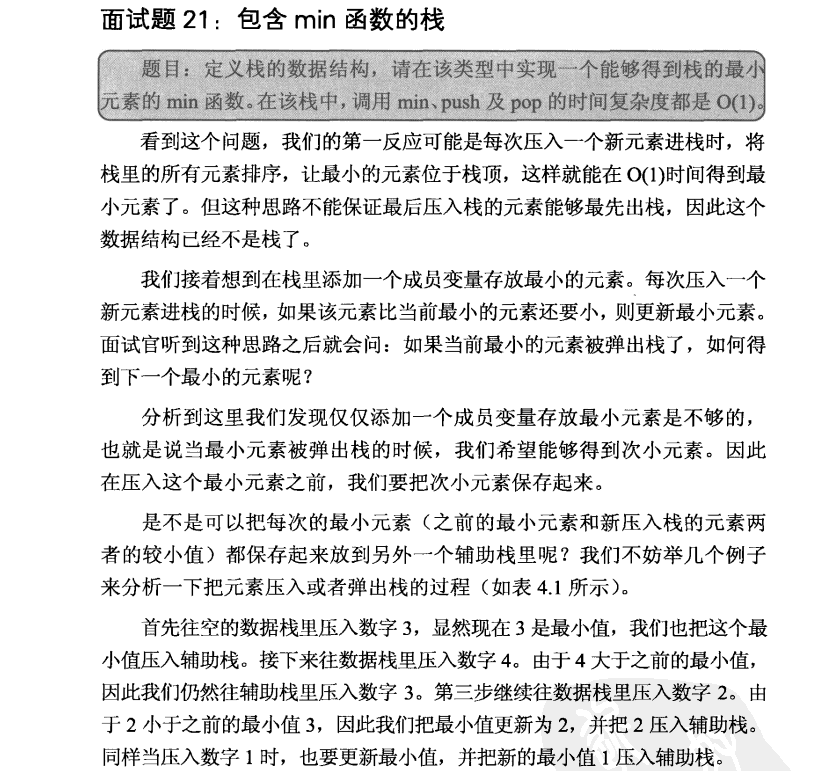
分析:对于时间复杂度O(1)的实现,主要使用两个栈来实现的,代码如下:
#include<stack> #include<assert.h> #include<iostream> #include<vector> #include<cstdlib> #include<string> #include<stdexcept> using namespace std; //模板类 template <typename T> class StackWithMin{ private: stack<int> m_data; //数据栈 stack<int> m_min; //辅助栈 public: void push(const T&); void pop(); T min() const; }; template <typename T> void StackWithMin<T>::push(const T& value) { m_data.push(value); if(m_min.size()==0 || value<m_min.top()) m_min.push(value); else m_min.push(m_min.top()); } template <typename T> void StackWithMin<T>::pop() { assert(m_data.size()>0 && m_min.size()>0); m_data.pop(); m_min.pop(); } template <typename T> T StackWithMin<T>::min() const { assert(m_data.size()>0 && m_min.size()>0); return m_min.top(); } int main() { StackWithMin<int> intStack; //压入栈 intStack.push(2); intStack.push(6); intStack.push(1); intStack.push(0); intStack.push(9); //弹出栈 intStack.pop(); //取最小值 cout << "min: " << intStack.min() << endl; return 0; }
面试题23:
面试题如下:
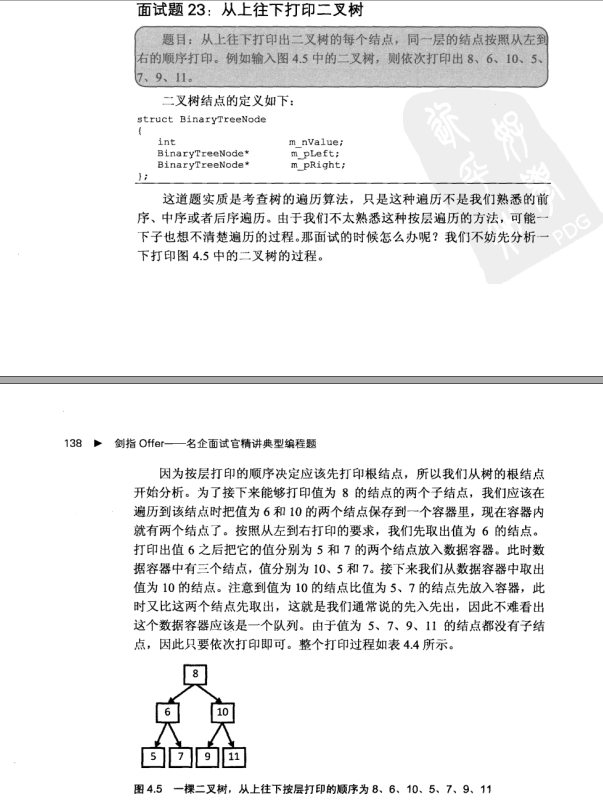
分析:考察对二叉树和队列的理解,灵活运用数据结构的特点进行码代码,代码如下:
#include<iostream> #include<cstdlib> #include<deque> using namespace std; struct BinaryTreeNode { int data; //节点数据 BinaryTreeNode *lchild,*rchild; //左孩子、右孩子 }; typedef struct BinaryTreeNode tree_t; /****** 构造一个二叉树 递归实现 参数:形参1:开始值,形参2:结束值 ******/ tree_t *CreateTree(int i, int max) { //递归结束条件 if(i > max) { return NULL; // == return 0; } tree_t *T; T = (tree_t *)malloc(sizeof(tree_t)); T->data = i; T->lchild = CreateTree(2*i, max); T->rchild = CreateTree(2*i+1, max); return T; } //先序遍历输出二叉树 void FirstRoot_DLR(tree_t *p) { if(p == NULL) return ; cout << " " << p->data; FirstRoot_DLR(p->lchild); FirstRoot_DLR(p->rchild); } //中序遍历输出二叉树 程序中未使用 void MiddleRoot_DLR(tree_t *p) { if(p == NULL) return; MiddleRoot_DLR(p->lchild); cout << " " << p->data; MiddleRoot_DLR(p->rchild); } //后序遍历输出二叉树 程序中未使用 void LastRoot_DLR(tree_t *p) { if(p == NULL) return; LastRoot_DLR(p->lchild); LastRoot_DLR(p->rchild); cout << " " << p->data; } //STL自带的deque(两端都可以进出的队列) void PrintFromTopToBottom(tree_t *pTreeRoot) { if(!pTreeRoot) return; deque<tree_t *> dequeTreeNode; dequeTreeNode.push_back(pTreeRoot); while(dequeTreeNode.size()) { tree_t *pNode = dequeTreeNode.front(); dequeTreeNode.pop_front(); cout << " " << pNode->data; if(pNode->lchild) dequeTreeNode.push_back(pNode->lchild); if(pNode->rchild) dequeTreeNode.push_back(pNode->rchild); } } int main() { tree_t *T1 = CreateTree(1,5); FirstRoot_DLR(T1); cout << endl; PrintFromTopToBottom(T1); cout << endl; return 0; }
面试题24:
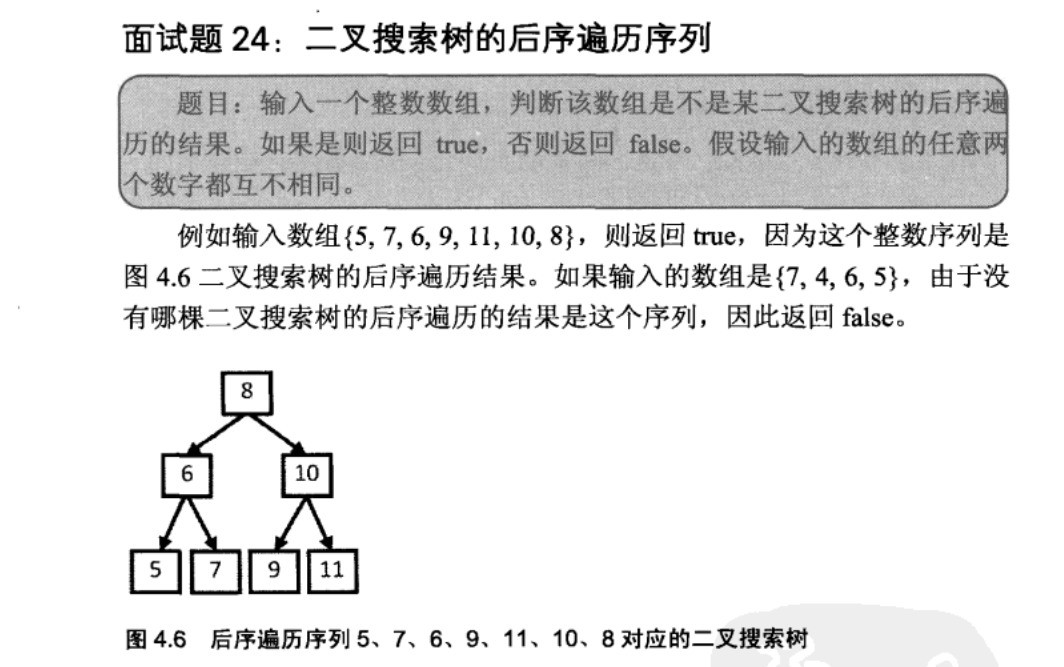
先简单介绍一下题目中的二叉搜索树的特点:左子树总比根节点小,右子树总比根节点大。代码如下:
#include<iostream> #include<cstdlib> #include<deque> using namespace std; struct BinaryTreeNode { int data; //节点数据 BinaryTreeNode *lchild,*rchild; //左孩子、右孩子 }; typedef struct BinaryTreeNode tree_t; bool VerifySquenceOfBST(int data[],int len) { if(data==NULL || len<=0) return false; int root = data[len-1]; //二叉搜索树的左子树节点小于根节点 int i = 0; for(;i<len-1;++i) { if(data[i] > root) break; } //二叉搜索树的右子树大于根节点 int j = i; for(;j<len-1;++j) { if(data[j] < root) return false; } //判断左子树是不是二叉搜索树 bool left = true; if(i > 0) VerifySquenceOfBST(data,i); //判断右子树是不是二叉搜索树 bool right = true; if(j > 0) VerifySquenceOfBST(data,j); return (left && right); } int main() { int data[]={5,7,6,9,11,10,8}; cout << boolalpha << VerifySquenceOfBST(data,7) << endl; return 0; }
面试题15:
面试题如下:
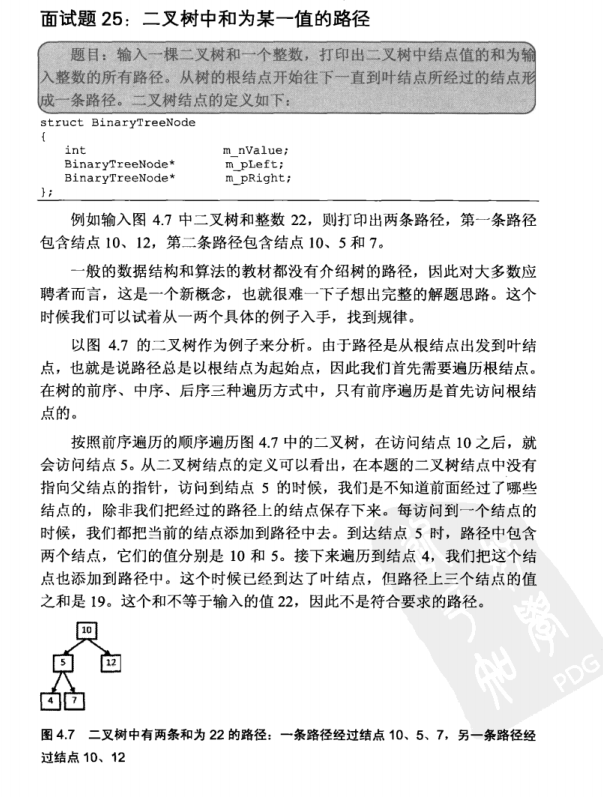
代码如下:
#include<iostream> #include<cstdlib> #include<deque> #include<stdio.h> #include<vector> using namespace std; struct BinaryTreeNode { int data; //节点数据 BinaryTreeNode *lchild,*rchild; //左孩子、右孩子 }; typedef struct BinaryTreeNode tree_t; /****** 构造一个二叉树 递归实现 参数:形参1:开始值,形参2:结束值 ******/ tree_t *CreateTree(int i, int max) { //递归结束条件 if(i > max) { return NULL; // == return 0; } tree_t *T; T = (tree_t *)malloc(sizeof(tree_t)); T->data = i; T->lchild = CreateTree(2*i, max); T->rchild = CreateTree(2*i+1, max); return T; } //先序遍历输出二叉树 void FirstRoot_DLR(tree_t *p) { if(p == NULL) return ; cout << " " << p->data; FirstRoot_DLR(p->lchild); FirstRoot_DLR(p->rchild); } //中序遍历输出二叉树 程序中未使用 void MiddleRoot_DLR(tree_t *p) { if(p == NULL) return; MiddleRoot_DLR(p->lchild); cout << " " << p->data; MiddleRoot_DLR(p->rchild); } //后序遍历输出二叉树 程序中未使用 void LastRoot_DLR(tree_t *p) { if(p == NULL) return; LastRoot_DLR(p->lchild); LastRoot_DLR(p->rchild); cout << " " << p->data; } void FindPath(tree_t *pRoot,int num,vector<int> &path,int &cursum) { cursum += pRoot->data; path.push_back(pRoot->data); //如果是根节点,并且路径上的和等于输入的值 //打印出这条路径 bool isLeaf = pRoot->lchild==NULL && pRoot->rchild==NULL; if(cursum==num && isLeaf) { cout << "A path is found: "; vector<int>::iterator iter = path.begin(); for(;iter!=path.end();++iter) printf("%d ",*iter); printf(" "); } //如果不是叶节点,则遍历子节点 if(pRoot->lchild != NULL) FindPath(pRoot->lchild,num,path,cursum); if(pRoot->rchild != NULL) FindPath(pRoot->rchild,num,path,cursum); //再返回子节点之前,在路径上删除当前节点 //并在cursum中减去当前节点的值 cursum -= pRoot->data; path.pop_back(); } void FindPath(tree_t *pRoot,int num) { if(pRoot == NULL) return; vector<int> path; int cursum = 0; FindPath(pRoot,num,path,cursum); } int main() { tree_t *T1 = CreateTree(1,5); FirstRoot_DLR(T1); cout << endl; FindPath(T1,8); return 0; }
总结:主要培养一种思想,通过举例的方法让抽象问题变为具体化。